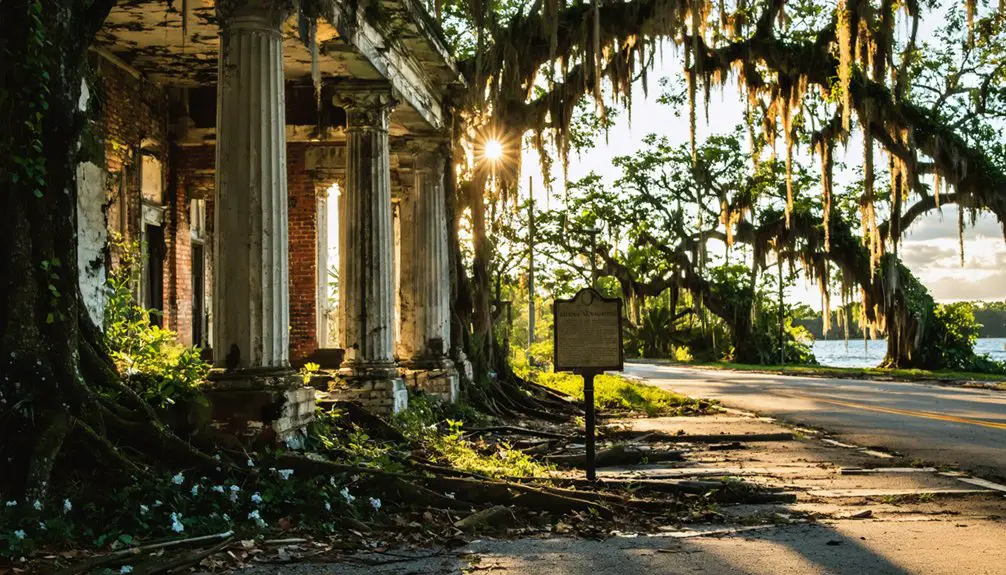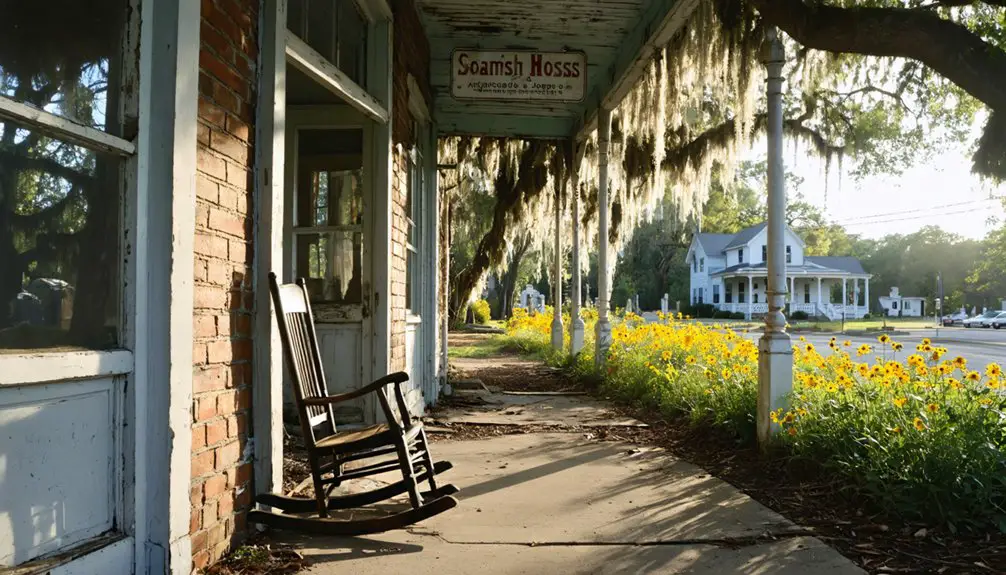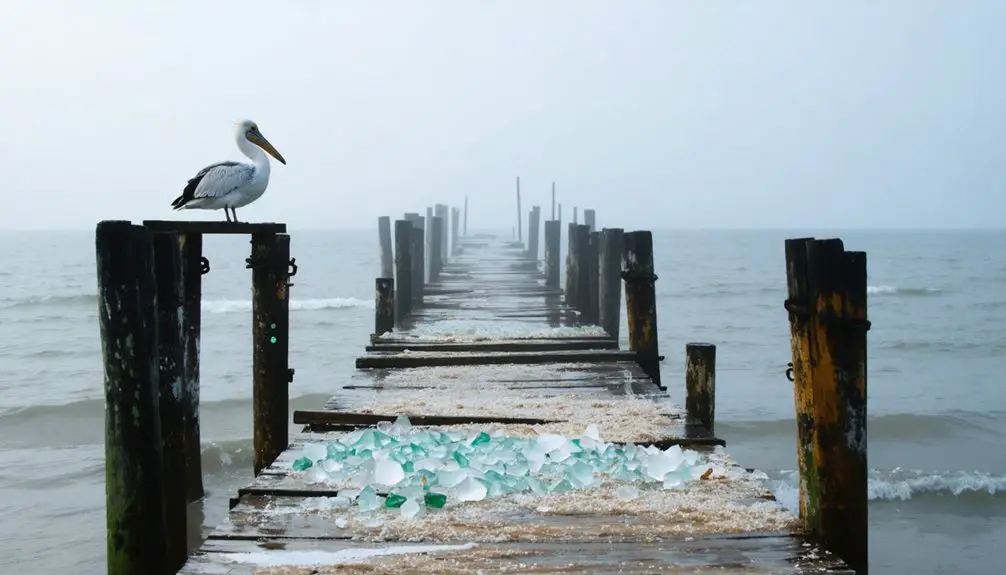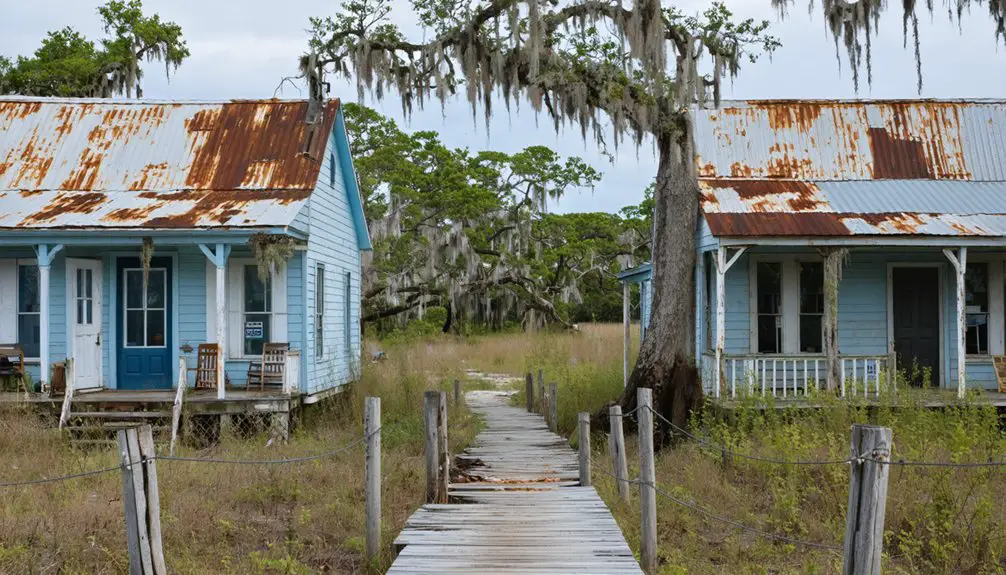St. Joseph, Florida’s most ambitious port city, rose from wilderness in 1835 to become the territory’s largest settlement by 1837 with nearly 12,000 residents. You’ll discover a once-thriving hub of cotton trade and Florida’s first Constitutional Convention site, earning it the nickname “Constitution City.” Between 1839-1841, devastating hurricanes, wildfires, and a deadly yellow fever epidemic reduced the population to fewer than 50 people, leading to complete abandonment by 1854. The ruins hold countless untold stories.
Key Takeaways
- St. Joseph was Florida Territory’s largest city by 1837 with 12,000 residents before becoming a ghost town by 1854.
- A devastating yellow fever epidemic in 1841 killed thousands, reducing the population from 5,000 to fewer than 400 residents.
- Multiple hurricanes in 1839 and 1841 destroyed vital infrastructure, including the wharf and streets, leading to widespread abandonment.
- Salvagers dismantled remaining structures, with materials repurposed in other Florida cities like Apalachicola and Pensacola.
- The site now houses the Constitution Convention Museum and contains mass graves of yellow fever victims.
The Birth of a Promising Port City
When wealthy promoters established St. Joseph in 1835, they chose a prime location with a 17-foot-deep natural harbor that would transform Florida’s maritime trade. Their urban planning centered around ambitious port facilities, including 4,000-foot wharves and extensive warehouses that showcased the era’s historical architecture. Just as skilled artisans were scarce and valuable during biblical times, the city’s founders recruited experienced craftsmen to construct its vital infrastructure.
You’d have witnessed remarkable progress as the city quickly became Florida Territory’s largest settlement, reaching nearly 12,000 residents by 1837. In December 1838, the city gained additional prominence when Constitutional Convention delegates gathered to draft Florida’s first State Constitution.
The founders’ masterstroke was constructing one of America’s first steam railroads, connecting St. Joseph Bay to Lake Wimico and the Apalachicola River system. This innovative infrastructure let merchants bypass the shallow Apalachicola port, where ships had to anchor 16 miles offshore.
Economic Prosperity and Trade Routes
St. Joseph’s rise to economic power centered on its strategic position as a cotton export hub, where you’d find over 6,000 inhabitants by 1837 managing shipments through its deep-water port.
You could track the town’s commercial success through its two major railroads, especially the Lake Wimico and St. Joseph Canal and Railroad, which connected inland cotton producers to the gulf-side port facilities.
The railroad networks let St. Joseph effectively compete with Apalachicola by redirecting cotton trade through its bay, while wealthy investors from Florida and neighboring regions backed the town’s rapid infrastructure development. The town established the Commercial Bank of Florida to support its growing trade operations.
The city’s prosperity and influence grew so much that it hosted Florida’s first constitutional convention in 1838, showcasing its political importance.
Cotton Export Hub
Three pivotal factors positioned St. Joseph as Florida’s premier cotton export hub in the late 1830s: its strategic location to intercept Georgia and Alabama cotton shipments, its natural deep-water harbor, and its competitive pricing structure.
You’d have witnessed the port’s meteoric rise as cotton cultivation from interior plantations flowed through the interconnected Chattahoochee, Flint, and Apalachicola river systems to St. Joseph Bay.
The city’s export strategies proved remarkably successful, handling over 50,000 cotton bales by December 1839.
A railroad to Iola provided crucial inland transportation for the growing port city.
The first Florida railroad was constructed to support the port’s ambitious shipping operations.
You could’ve seen massive ships loading directly at the harbor, bypassing the cumbersome 16-mile barge transfer required at rival Apalachicola. This efficiency helped St. Joseph grow into Florida Territory’s largest city, with 12,000 residents and thriving international trade connections to New England and European markets.
Railroad Transportation Networks
Ambitious plans to expand cotton trade drove the development of Florida’s first steam railroad in 1836.
You’d have witnessed a remarkable shift in transportation when the Lake Wimico and St. Joseph Canal and Railroad abandoned their original canal plans for more efficient railroad innovations. This 8-mile line connected St. Joseph to Columbus Bayou, initially using horse and mule power before introducing steam locomotives.
Despite transportation challenges, you could’ve shipped goods through an expanding network that aimed to capture trade from the Apalachicola, Flint, Chattahoochee, and Chipola rivers. Using 5ft track gauge, the railroad’s construction included wood rails and strap iron.
The high transportation costs ultimately hindered the city’s commercial growth and development.
The railroad helped St. Joseph’s population boom to over 4,000 residents, though it struggled against Apalachicola’s established port.
The Constitutional Convention Legacy

Located on Florida’s Gulf Coast, the historic 1838 Constitutional Convention in St. Joseph marked a pivotal moment in Florida’s path to statehood.
You’ll find that 56 territorial delegates gathered for 34 days to craft the constitutional framework that would govern Florida’s future. The town’s selection over Tallahassee reflected the need to bridge regional divisions between East and Middle Florida during the statehood process. Prominent figures like Robert Raymond Reid helped lead the constitutional drafting efforts.
Today, you can explore this legacy at the Constitution Convention Museum State Park, opened in 1956 on 14 acres of the former settlement. A 1923 monument dedication commemorates the delegates who shaped Florida’s bid for statehood.
Visit the Constitution Convention Museum State Park to experience Florida’s constitutional birthplace, preserved on the grounds where history was made.
You’ll witness life-size, audio-animated recreations of the historic debates and view artifacts from the original town. While St. Joseph’s existence lasted only nine years, its impact on Florida’s governmental foundation continues through six subsequent state constitutions.
Natural Disasters Strike Paradise
Tragedy struck St. Joseph with devastating force in 1841 when a yellow fever epidemic ravaged the population, highlighting the town’s lack of disaster preparedness.
Within months, a powerful hurricane slammed into the weakened community, destroying buildings and washing ships ashore with its massive tidal surge.
The blows kept coming as wildfires swept through later that year, consuming what little remained of the once-thriving port town.
Any hope of community resilience was crushed when another major hurricane in 1844 swept away most surviving structures.
The economic impact was catastrophic – the essential railroad closed, cotton prices plummeted, and the population dwindled from 12,000 to mere hundreds.
The Yellow Fever’s Deadly Toll

The devastating yellow fever epidemic of 1841 began quietly when an infected ship’s captain died upon reaching St. Joseph’s harbor. You wouldn’t have known then that this single death would trigger Florida’s most catastrophic disease outbreak.
By June, yellow fever spread rapidly through the bustling port town, first striking wharf workers before consuming entire neighborhoods. The town’s only doctor fled, leaving residents to face the deadly “yellow jack” alone.
Terror gripped St. Joseph as yellow fever ravaged the port, claiming lives while their only hope of medical care abandoned them.
You’d have witnessed Governor Reid, his family, and countless prominent citizens succumb to the fever within days.
The community impact was staggering – within months, St. Joseph’s population plummeted from 5,000 to fewer than 400. Those who survived either fled or died trying, leaving behind empty homes that would soon be claimed by hurricanes and fires.
From Bustling City to Abandoned Ruins
You’d be amazed how St. Joseph rose from a land dispute in 1835 to become Florida Territory’s largest city by 1837, with nearly 12,000 residents and one of Florida’s first steam railroads.
Nature released its fury on the bustling port through a devastating sequence – yellow fever in 1841, a massive fire that same year, and a catastrophic hurricane in 1844.
The combination of these disasters reduced the once-mighty city to ruins, forcing survivors to abandon their homes and leaving St. Joseph to fade into wilderness until its land was sold to the U.S. government in 1940.
Rapid Rise to Power
Founded in 1835 along St. Joseph Bay‘s shores, this ambitious settlement quickly transformed into a powerhouse of urban development. You’d find a natural deep-water harbor stretching 17 feet down, attracting merchants and settlers keen to challenge Apalachicola’s trading dominance.
Within just two years, the population exploded to 6,000-12,000 residents, making it the Florida Territory’s largest city.
The town’s historical significance peaked in 1838 when it hosted Florida’s first Constitutional Convention, earning the nickname “Constitution City.” You could’ve witnessed 56 delegates gathering to draft the document that would guide Florida to statehood.
With two railways connecting to the Apalachicola River and a bustling port handling cotton and lumber exports, St. Joseph embodied the spirit of commercial freedom and territorial expansion.
Nature’s Devastating Blows
Despite its rapid ascent to prominence, St. Joseph’s downfall began with nature’s relentless assault. In 1839, a powerful hurricane ravaged the town, sending ships crashing ashore and demolishing buildings.
The worst blows came in 1841 when a ship brought yellow fever to the bustling port. The epidemic decimated the population from 5,000 to just hundreds, filling mass graves that remain today.
That same year, two more hurricanes battered the weakened town, destroying the crucial wharf and flooding streets with storm surge. As if nature hadn’t dealt enough damage, wildfires swept through the remaining structures.
Salvaging the Remains

As St. Joseph’s population dwindled in the early 1840s, salvage strategies became increasingly limited.
You’d have found fewer than 50 residents by 1843 attempting to recover anything of value from the hurricane-ravaged town. The closure of the St. Joseph and Iola Railroad further complicated salvaging efforts, making material transport nearly impossible.
Some resourceful salvagers managed to dismantle grand homes, transporting them by barge to Apalachicola. The most notable material reuse occurred when Pensacola repurposed bricks from St. Joseph’s cotton warehouses to pave Palifox Street.
Multiple natural disasters, including devastating hurricanes in 1843 and 1846, left precious little to salvage. By 1854, complete abandonment of the town meant organized recovery efforts had ceased entirely, leaving the remains to decay until modern archaeological preservation began.
Modern-Day Historical Significance
While St. Joseph’s physical structures have vanished, its cultural heritage endures through the Constitutional Convention Museum and St. Joseph Peninsula State Park.
You’ll discover the town’s archaeological significance at these sites, where artifacts from indigenous Weeden Island, Fort Walton, and Swift Creek cultures merge with colonial Spanish and French relics.
Today’s Port St. Joe, nestled near the ghost town site, preserves this layered history.
Modern Port St. Joe stands as a living testament to the rich, multilayered history of this storied coastal region.
You can explore the museum to learn about Florida’s territorial period and the pivotal 1838 constitutional convention that shaped the state’s future.
The peninsula’s protected parklands offer you a chance to walk where Native Americans once lived and where Florida’s earliest governance took root, making it an essential destination for those seeking to understand the state’s complex past.
Frequently Asked Questions
What Indigenous Tribes Originally Inhabited the St. Joseph Area Before Settlement?
You’ll find the Weeden Island culture was first, followed by the Fort Walton and Swift Creek Native tribes, all holding historical significance through their hunter-gatherer societies along St. Joseph’s coastal waters.
How Much Did Typical Properties Cost During St. Joseph’s Peak Years?
You’d laugh at today’s housing crisis – back then property values soared from economic factors like cotton trade and port access, with prime waterfront lots fetching several thousand dollars before crashing by 1841.
What Happened to the Cemetery and Burial Grounds After Abandonment?
You’ll find the cemetery survived but deteriorated, with many graves becoming unmarked. Despite burial ground discoveries in surrounding areas, preservation efforts now protect only a small fenced portion of the original grounds.
Were There Any Documented Paranormal Activities in St. Joseph’s Ruins?
You’ll find numerous ghost sightings reported at the Batty Mansion, where paranormal investigations document shadow figures, unexplained footsteps, and apparitions of Armstrong and Eliza Batty in period clothing.
How Did St. Joseph’s Building Architecture Compare to Other Florida Cities?
While other cities boasted Victorian influences and coastal adaptations, you’d find St. Joseph’s buildings were simply functional wood-frame structures, lacking the elaborate stone and brick architecture seen in St. Augustine or Pensacola.
References
- https://www.clickorlando.com/features/2025/04/17/floridas-biggest-city-was-utterly-destroyed-by-a-hurricane-heres-whats-left-now/
- https://en.wikipedia.org/wiki/St._Joseph
- https://freegnv.com/2020/04/24/floridas-forgotten-city/
- https://www.youtube.com/watch?v=ufASxvUOQE8
- https://www.hometowncurrency.org/st-joseph/
- https://www.visitgulf.com/plan-your-trip/about-gulf-county/history/
- https://portofportstjoe.com/port-history.cfm
- https://sites.rootsweb.com/~fljackso/OLDSTJOE.htm
- https://www.florida-backroads-travel.com/port-st-joe-florida.html
- https://stars.library.ucf.edu/cgi/viewcontent.cgi?article=1542&context=fhq



